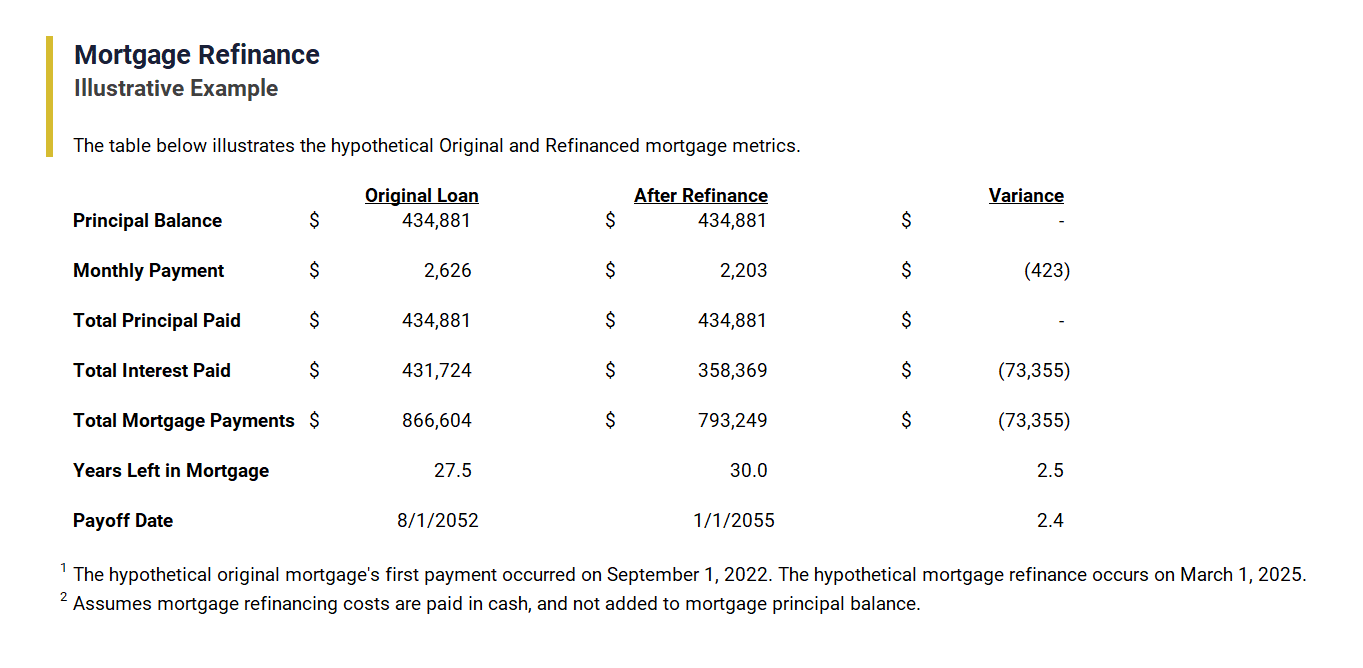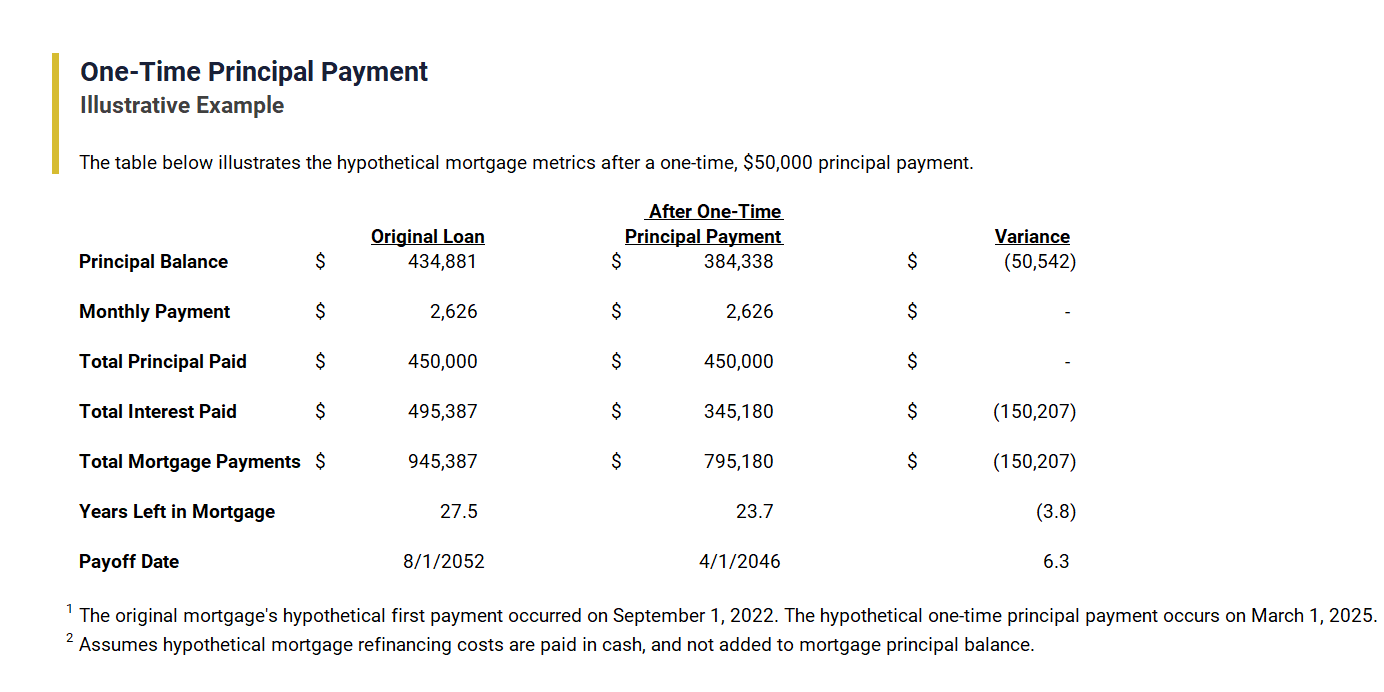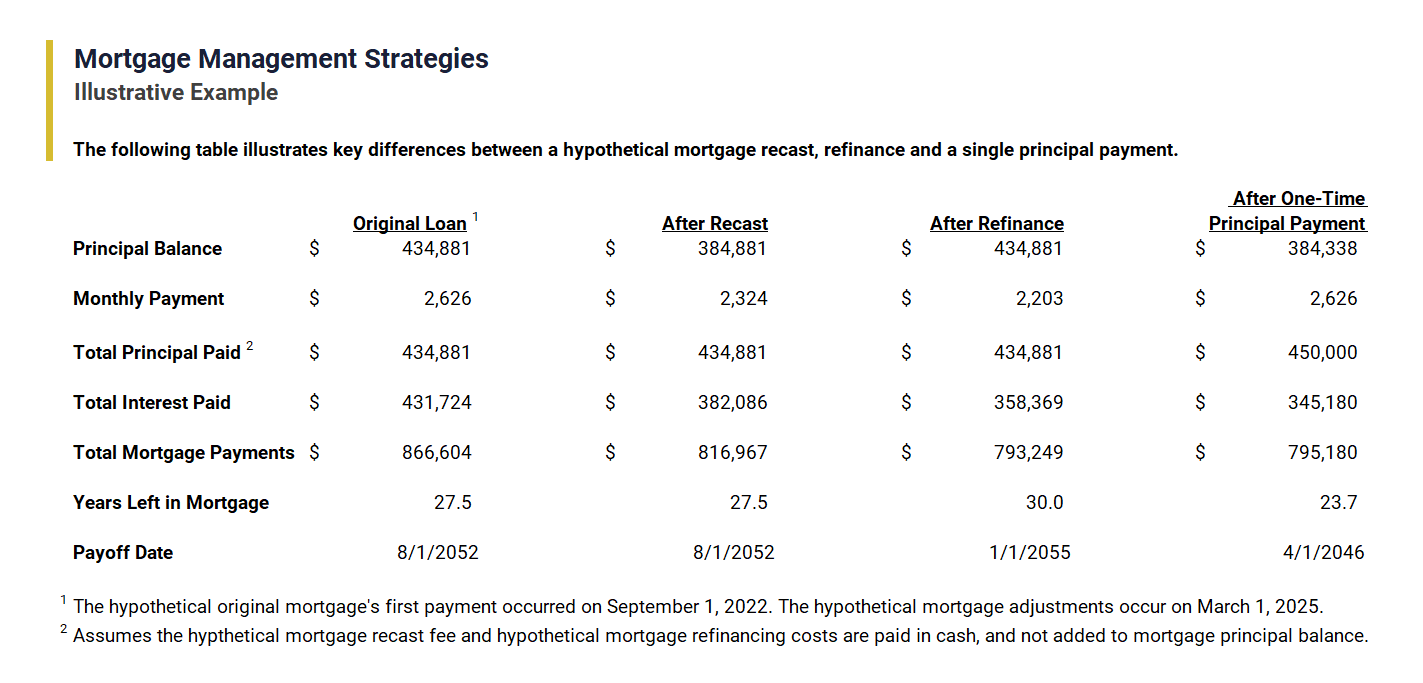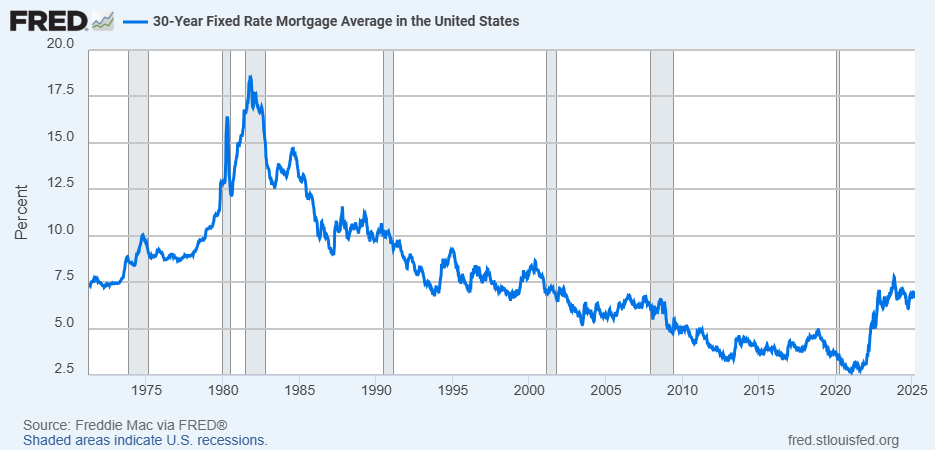Homeownership can offer families a lifetime of fun memories. The dream of owning a home, for many couples, becomes a reality through the support of a mortgage. This financial commitment can open the door to stability, security, and a place to call your own. Explore and compare three mortgage adjustment tools available to many homeowners. While mortgage refinancing is an oft-discussed strategy, there’s never been a better time for hardworking homeowners to also understand mortgage recasting and lump-sum principal payments.
Learning Points
Mortgage Management Techniques to Consider
There are multiple mortgage strategies you can evaluate as your family’s goals and needs change. Here’s a quick overview of the three mortgage management techniques we’ll discuss:
- Mortgage Recasting allows you to lower your monthly payment without changing your loan terms and have a lump sum available.
- Mortgage Refinancing is helpful if you aim to secure a lower interest rate, change your loan term, or need cash out.
- Lump-sum principal-only payment lets you pay off your mortgage faster and reduce the total interest you pay without altering your monthly payment.
Recasting vs. Refinancing vs. Lump-Sum Principal Payment
Mortgage Recasting
Mortgage recasting is the process where you make a one-time, lump-sum payment towards your mortgage’s principal balance.
During mortgage recasting, your mortgage lender keeps your original mortgage term and interest rate the same. Many mortgage lenders charge a fee for mortgage recasting. Once you pay your recast fee and follow the lender’s mortgage recasting application process, your mortgage lender then re-amortizes your loan.
Meaning, your mortgage lender recalculates a new monthly principal and interest payment based on the loan’s new, lower principal balance.
This in turn, means your monthly mortgage payments are now lower for the remainder of your mortgage.
The lower monthly payment due to re-amortization is a defining feature of mortgage recasting. Additionally, mortgage recasting could result in a lower amount of total interest you pay over the remaining life of your mortgage compared to your original mortgage.
Topics such as mortgage recasting, like so many others in financial planning, intersect with the world of tax. Make sure you coordinate with a qualified tax professional about your specific situation.
Mortgage Refinancing
Mortgage refinancing means replacing your existing loan with a new one, typically to secure a lower interest rate, change the loan term, or switch from an adjustable-rate mortgage to a fixed-rate one.
This can lower your monthly payments and reduce the total interest paid over the life of the loan.
Mortgage refinancing can also give you access to a portion of the equity you have in your home.
Single, Lump-Sum Principal Payment
A single, lump-sum principal payment is an additional payment made directly towards the loan principal, not the interest. This reduces the principal balance faster, which can save you money on interest and shorten the loan term. As such, it doesn’t lower your monthly payment.
If you are considering a principal-only payment, your mortgage likely allows you to regularly pay down your principal balance.
As you look to evaluate each strategy, you’ll want your goals and personal situation to guide your review of each strategy.
If one of these approaches is going to strain other parts of your life, throwing a well-crafted plan out of balance, sticking with your current approach might just be the right choice.
Illustrative Examples: Refinancing, Lump-Sum Principal Payment, and Recasting
To show how these different techniques work, let’s explore a hypothetical mortgage. Then, we can adjust the mortgage by each technique.
The figures used to create each scenario are hypothetical and simply meant for educational purposes. All the figures have also been rounded to the nearest whole dollar.
For these illustrative examples, let’s consider an original mortgage with the following key details:
- First Payment Date: 9/1/2022
- Original Principal Balance: $450,000
- Annual Interest Rate: 5.750%
- Term (Years): 30.0 years
And with that, let’s dive in…
Illustrative Example: Mortgage Refinancing
Now, for the hypothetical mortgage refinancing, we assume the following on the new mortgage:
- New Annual Interest Rate: 4.500%
- New Principal Balance: $434,881
- First Payment Date: 3/1/2025
The following table shows how mortgage refinancing lowers both the monthly payment as well as the total interest paid.
It also highlights that mortgage refinancing creates a new 30-year term for the mortgage.

Illustrative Example: Lump-Sum Principal Payment
The following hypothetical lump-sum principal payment illustrates how the monthly mortgage payment is unchanged while the total interest paid is lower than the original mortgage. It also shows how making extra mortgage principal payments early can significantly reduce the total interest paid over the life of the mortgage.
Lastly, this example shows how much sooner the mortgage can be paid back after a significant principal reduction.
Quantifying how much quicker you can pay off your mortgage using a lump-sum principal payment can help you with your other long-term planning.

This last table below illustrates key differences between mortgage recasting, mortgage refinancing, and a one-time principal payment.

Current Mortgage Interest Rates
As a homeowner, you value making smart financial decisions that support your goals. As a long-term thinker, you want to understand how your decisions will look over a span of decades rather than months or years.
Your mortgage interest rate has a significant influence over your long-term planning. Your mortgage interest rate affects your family’s annual spending, tax planning, and long-term planning.
As of March 6, 2025, the average national mortgage interest rates were 5.79% [i] and 6.63% [ii] for 15- and 30-year mortgages in the United States, respectively.

Image Source: Freddie Mac, 30-Year Fixed Rate Mortgage Average in the United States [MORTGAGE30US], retrieved from FRED, Federal Reserve Bank of St. Louis; https://fred.stlouisfed.org/series/MORTGAGE30US, March 6, 2025.
Mortgage refinancing is a commonly discussed mortgage strategy when interest rates lower significantly. With mortgage interest rates originating between ~6.0% and ~7.2% since the beginning of 2024, mortgage refinancing might not currently be actionable for many homeowners.

The Next Step
Hopefully you found this overview of mortgage refinancing, recasting and lump-sum principal payments helpful and educational.
Do any of these mortgage strategies move you closer to your savings priorities? Does it mean you need to make some tradeoffs? If so, what’s the right mix of solutions for you or your family?
You can review your household cashflow, mortgage debt, and evaluate potential alternatives that support your goals. It’s important to review and adjust to changes in your personal situation and the world around you.
Are you on track for your short-term goals, like making memories with your family by going on vacations together? How confidently are you approaching saving and investing for your long-term aspirations, like retiring or pursuing a meaningful second career?
We help busy parents and individual professionals like you develop financial plans to address questions like:
- How can we save for a fulfilling retirement beyond our 401(k) plans?
- What does it take to save for the kids’ education and make a lifetime of memories along the way?
- These causes are close to our hearts – what are our options to give even more meaningful support?
As your financial planner in Saint Louis, we can help you get organized and start feeling more confident that you are making progress towards your savings priorities.
Working with your financial planner in Saint Louis can provide you with the right mix of accountability, collaboration, and long-term thinking.
When you know who and what are truly important, we can help you create incredible clarity about your spending and savings priorities. Clarity to confidently save for and spend on what matters.
If you’re ready to take the next step together, let’s talk.
Disclosure
This commentary is provided for educational and informational purposes only and should not be construed as investment, tax, or legal advice. The information contained herein has been obtained from sources deemed reliable but is not guaranteed and may become outdated or otherwise superseded without notice. Investors are advised to consult with their investment professional about their specific financial needs and goals before making any investment decision.
[i] Freddie Mac, 15-Year Fixed Rate Mortgage Average in the United States [MORTGAGE15US], retrieved from FRED, Federal Reserve Bank of St. Louis; https://fred.stlouisfed.org/series/MORTGAGE15US, March 6, 2025.
[ii] Freddie Mac, 30-Year Fixed Rate Mortgage Average in the United States [MORTGAGE30US], retrieved from FRED, Federal Reserve Bank of St. Louis; https://fred.stlouisfed.org/series/MORTGAGE30US, March 6, 2025.


